hartacus
Member
I've had to sideline my Canon A-1 due to a few rolls of film that have demonstrated a back focusing issue, especially with close subjects in low light where the FD 50mm f/1.4 lens has a paper-thin depth of field. Today I had a bit of time so I set about attempting to fix it. I suspected that the mirror angle might be incorrect and the mirror stop might need adjusting. However, using another SLR with known-good focus as a collimator showed that infinity focus was spot on, and I confirmed this using a distant (>300m away) object. I was surprised by this - checked it several times and I'm fairly confident of that result. I guess I hadn't noticed it during use because I don't come across many situations where I'm taking photos of distant objects with the lens wide open.
So I tested a much closer subject, at or near the lens minimum focus distance. Initially with the FD 50mm f/1.4 SSC lens. The subject was a piece of film, cut between two sprocket holes, placed at around 70 degrees to the film plane angle so that when focused (using the viewfinder) on the leading edge of the piece there'd be a relatively clear visual indicator of whether the focus (on the film plane) was behind the leading edge. Focus at the film plane appeared to be at around the second sprocket hole, not the leading edge. I re-tested with an FL 50mm f/1.8 and got a very similar result, which leads me to think that it's not the lens.
What could cause an SLR to have accurate focus at infinity but back focus for close subjects?
(Note that I re-seated the focusing screen not long ago, taking care to insert it in the correct orientation as it had been replaced backwards by a previous owner.)
So I tested a much closer subject, at or near the lens minimum focus distance. Initially with the FD 50mm f/1.4 SSC lens. The subject was a piece of film, cut between two sprocket holes, placed at around 70 degrees to the film plane angle so that when focused (using the viewfinder) on the leading edge of the piece there'd be a relatively clear visual indicator of whether the focus (on the film plane) was behind the leading edge. Focus at the film plane appeared to be at around the second sprocket hole, not the leading edge. I re-tested with an FL 50mm f/1.8 and got a very similar result, which leads me to think that it's not the lens.
What could cause an SLR to have accurate focus at infinity but back focus for close subjects?
(Note that I re-seated the focusing screen not long ago, taking care to insert it in the correct orientation as it had been replaced backwards by a previous owner.)












